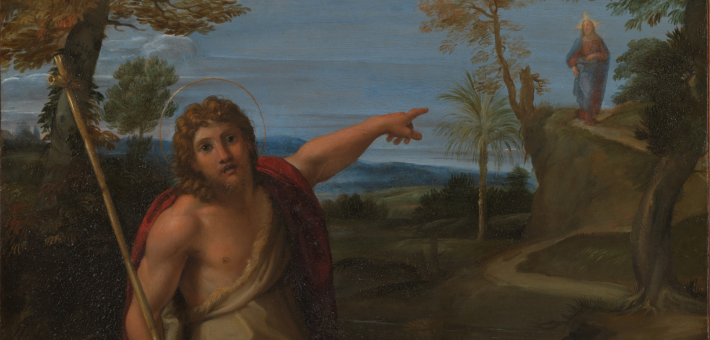Commentary on Isaiah 12:2-6
As we enter the third week of Advent, anticipation builds. Christmas lights twinkle, carols fill the air, and excitement grows. Yet in this season of waiting, Isaiah 12:1–6 invites us to pause and reflect on a deeper joy that comes from the most miraculous and awe-inspiring present ever given: the joy of divine salvation that flows from the powerful presence of the Creator of the cosmos. This ancient song of praise resonates with our Advent journey, reminding us that our celebration doesn’t revolve around festive but cheap trappings––it centers on God’s transformative presence among us.
Isaiah 12:1–6 presents us with a short, but beautiful and poignant, psalm of praise and thanksgiving. It serves as a pivotal conclusion to the first major section of the book of Isaiah (chapters 1–12). To fully appreciate its significance, we must understand its context within the larger narrative of Isaiah’s prophecies.
The book of Isaiah can be divided in various ways, but a significant transition occurs between chapters 12 and 13. While chapters 1–12 form a fairly cohesive unit that focuses on oracles for Judah and Jerusalem, chapter 13 shifts focus to oracles against foreign nations––a theme that continues, with interruptions, through chapter 23. If possible, include verse 1 of chapter 12 in your public reading, as it provides crucial context for what follows.
Isaiah 1 serves as an introduction to the entire book, spanning all 66 chapters. However, the earliest, and oldest, collection of Isaianic material is likely found in chapters 2–12. This section begins with a beautiful hymn of cosmic salvation (2:2–4) and concludes with our passage, a short hymn of praise and thanksgiving. Though brief, chapter 12 plays a vital role in the structure of Isaiah’s complex message.
Isaiah 2–5 is largely critical of Judah and Jerusalem. Yet the vision in 2:2–4 offers hope for a future cosmic transformation, where all nations seek God’s instruction (torah). The following chapters reveal how far the people have strayed from this ideal, with Isaiah urging them to live up to their divine calling. The call narrative of chapter 6 is itself a response to this ethically challenging context: YHWH’s presence, and YHWH’s commission to the prophet Isaiah, are terrifying (chapter 6). Isaiah 7–8 recalls the crisis of 734 BCE, when King Ahaz responded to the threatening siege of Jerusalem by calling on Assyria for help, against Isaiah’s advice. Yet YHWH continues to work through Isaiah and those who have followed his teaching (8:16–17).
Yet then, when all might seem lost, Isaiah receives more visions of hope, recalling 2:2–4. In chapter 9, we read of a promised Davidic king who will rule with justice and bring light and liberation. And in Isaiah 11, we hear of a royal leader who will usher in a period of cosmic harmony and restful, playful peace that reverberates throughout all creation––albeit interrupted with more judgment of the leaders of Judah for their unethical treatment of the vulnerable (10:1–4).
While temporarily using Assyria to judge the leaders of Judah, YHWH will, nevertheless, also issue judgment on the kingdom of Assyria for its role in widespread injustice (10:5–19). Yet unlike Isaiah 5:25–26, which ended the first subsection of the book (chapters 2–5) on a sour note of judgment, this time around the text soars to rhetorical heights of praise for the salvation of the people.
The vision of the peaceable kingdom in 11:1–9 shifts to a foretelling of a future time in which YHWH will recover the “remnant” of the people who have been scattered throughout the foreign nations near and far, even the “four corners of the earth” (verses 11–12). YHWH will restore the relationship between the former northern tribes (“Ephraim,” verse 13) and Judah, and will again triumph over the chaotic powers of Egypt’s “sea,” referencing images of threatening counter-creation forces from ancient Near Eastern imagery as well as the exodus story (verse 15).
Then, YHWH will liberate the people in a second exodus, “leading people across” the sea on dry land (verse 15), and at that point there will be “a highway from Assyria” leading the deported and demoralized people of God home to start a new community that will live out the vision foreseen in Isaiah 2:2–4. It will be just like “when they came up from the land of Egypt” (verse 18). This “highway” foreshadows the beautiful poem of divine deliverance from exile in Babylon in chapter 40, as well as other mentions of “highways” of deliverance in 19:23, 35:8, and 62:10.
YHWH’s “fast track” to salvation is a major theme of Isaiah. In chapter 12, then, we hear a song of praise and thanksgiving that responds to this foretelling of YHWH’s mighty power to save; after chapter 12, the book enters into an intense meditation on YHWH’s work among, with, and against the dominant foreign powers who have assailed Judah and Israel––a section like those found in other prophetic books, called the “oracles against the nations” (chapters 13–23).
So, in context, Isaiah 12 is a song of praise in anticipation of a new exodus wherein God miraculously saves those under the control of an evil power––one represented by cosmic forces of chaos. It’s no wonder, then, that it is chosen as a reading for the time of Advent. Reading it in this light, we can think of “that day” (12:1) as a cosmic event that collapses the various points of time in which God has acted decisively to save.
YHWH was righteously angry with us––Isaiah gives plenty of reasons for this in chapters 2–11, but most prominent are the ways in which we participate in the oppression of the vulnerable, the needy, and those over whom we have some modicum of power (see also 3:10–11, 14–15; 5:7–10; 10:1–4). These are not insignificant things that YHWH should ignore. Nevertheless, YHWH’s “anger has turned away” so as to “comfort” Israel in its distress (12:1).
The author here asks us to “behold,” or see, that the presence of God is indeed salvation itself (Isaiah 12:2). This is not lost on a reader of Isaiah who can understand Hebrew: Isaiah’s name literally means “Yah[weh] is salvation.” This is, incidentally, related to Jesus’ name (“Salvation”). This confidence leads the Isaianic author to “trust and not be afraid” (verse 2). The phrase “do not be afraid” often accompanies oracles of salvation: it tells someone that salvation is about to arrive, so one need not fear any longer (see also Isaiah 7:4; 8:12; 35:4; 36:7; 40:9; 41:10, 13–14; 43:1, 5; 44:2, 8; 51:7; 54:4). YHWH, and nothing else, constitutes our strength and our hope in salvation, which is why YHWH alone is “our song” that we sing in praise (verse 2).
Then the poet shifts imagery, returning to water––but instead of chaotic waters we find “wells of salvation” that deliver water, reminding us of the wilderness journey and the miraculous provision of life-giving sustenance in the hopeless desert (see Exodus 17). The psalmist then tells us that when the day of salvation arrives, we will joyfully burst into a song of thanksgiving and praise in which we will bear witness to God’s saving power in our lives, to the very ends of the earth (verse 5).
The section ends with a call for everyone in Jerusalem to join in: “Shout, and sing for joy, O inhabitant of Zion,” precisely because God is with us (immanuel, 7:14); “Great in your midst is the Holy One of Israel” (verse 6). Amen: salvation is about to be among us, indeed.


December 15, 2024